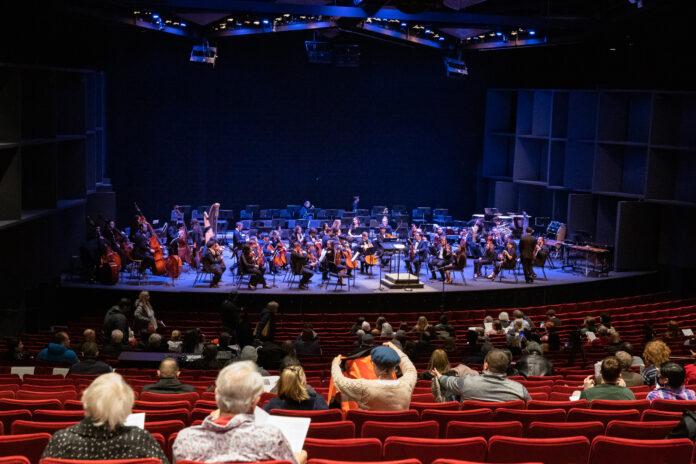
The UNLV Symphony Orchestra returned to Artemus Ham Hall on March 29 to perform a variety of French and Czech compositions. The orchestra is led by UNLV’s Director of Orchestras, Taras Krysa, and features guest conductor Eric Maine and mezzo-soprano Ana Elisa Portes.
The first composition featured was Claude Debussy’s, “Prelude to the Afternoon of the Faun.” The song portrays a faun, a half-goat and half-human creature, taking a nap, then waking up from that nap to play the flute. After playing the flute, the faun chases nymphs around the woods as they play together with the faun falling back asleep afterward.
The flute begins the melody, then string instruments join in creating a faint splattering of harmonies. The music is written in an impressionistic style, similar to that of paintings by Renoir and Monet, with no clear melodies or harmonies to focus on. This piece is meant to represent an in-between state of consciousness, where the audience doesn’t know if the faun is still asleep and dreaming the sequence with the nymphs or whether it is happening in reality.
The piece is led by guest conductor Eric Maine, an orchestra conducting student who is graduating this semester to be a conductor. The piece is very difficult to conduct according to Krysa, as he said, “[The piece] is very busy for the conductor and the meter [or rhythm] changes every bar. It is a difficult task in terms of interpretation.”
Krysa proudly notes, “It’s a rite of passage for a young conductor to be able to conduct this piece and Eric is doing a fine job.”
“Scheherazade” by Maurice Ravel followed shortly after with Ana Elisa Portes as the soloist. Portes won the annual UNLV Concerto Competition to become the soloist in the symphony orchestra. Portes placed first out of a competitive pool of 10 to 25 students vying for the top spot.
The violins begin this composition, then Portes joins singing in French. Ravel was heavily inspired by the composer of the previous piece, Claude Debussy. “Scheherazade” is modeled off the popular Middle Eastern collection of folk tales, “One Thousand and One Nights,” more commonly known in English as “The Arabian Nights.”
“Scheherazade” is named after the tales’ heroine and narrator.
After intermission, the final composition of the night was “Sinfonietta” by Leos Janáček. Janáček was a Czech composer who lived between the 19th and 20th centuries. He originally trained as an organist, which is why much of his music incorporates the organ’s sound.
The brass choir rises, signaling the beginning of the last composition: a lively and flashy piece that illustrates Janáček’s childhood memories.
There are five movements in this piece, with the second to last movement celebrating the liberation of Czechoslovakia. Every instrument joins in the finale, playing the triumphant last melodies.
Compared to the beginning of the semester, the students that make up the orchestra are now more accustomed to their instruments. Krysa says, “At this time of the year, [students] usually process information quicker, they learn quicker, they know what needs to be done quicker.” He then jokes, “Whether they do what needs to be done, that’s another question.”
The final orchestra performance of the semester led by Krysa will be on May 7 and will be a collaboration between UNLV’s Symphony Orchestra and the Las Vegas Academy of the Arts.
The orchestra will play Richard Wagner and Hector Berlioz’s compositions.
